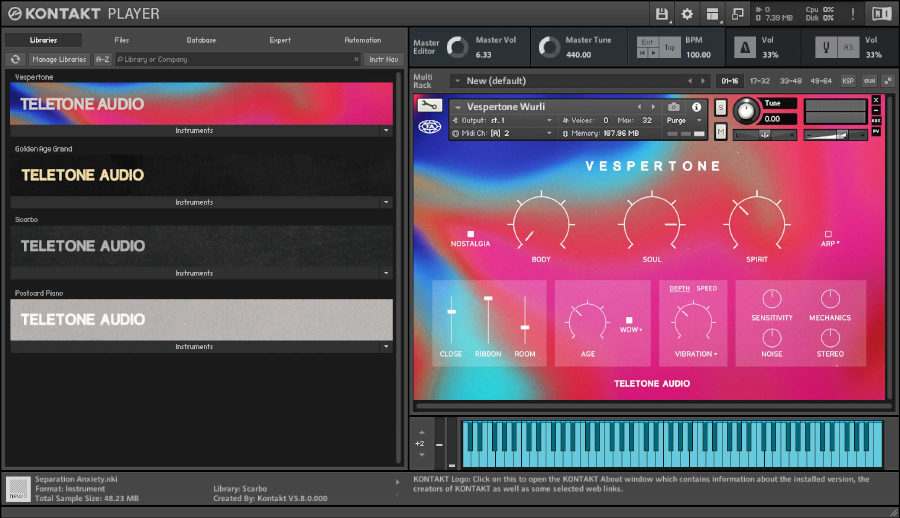Teletone Audio has been working since 2017 to bring a fresh take and flavour to some revered keyboards with their Vespertone virtual instruments. We had a deep dive into their collection, Vespertone. A collection of vintage keyboard instruments made with great care.
From the advent of digital studio recording, we’ve seen a world of ‘classic’ emulation attempts for many instruments, those with ‘acoustic’ counterparts already well established in the studio; instruments such as the simple piano, Fender Rhodes or Wurlitzer 200A. Over decades these classic instruments have increased dramatically in cost, and their digital counterparts have slowly begun sounding increasingly realistic, believable and more natural.
Vespertone is a collection of a Wurlitzer 200, a 1930s vibraphone, a suitcase Rhodes, and a Jenco Celeste captured acoustically with incredible realism and great care. On top of the immense task of recreating realistic versions of these pieces, Teletone Audio has gone steps further and offered a huge amount of options for manipulation of the instruments, from slight modulation to the point of complete abstraction.
Teletone Audio is a virtual instrument company out of Nashville Tennessee that has put a whole lot of heart, soul, and love into its pieces. The company was formed out of founder Jeremy Larson’s quest to reinvigorate his love for the piano, flourishing from a single manipulated piano (the Postcard Piano) to multiple unique and highly usable keyboards. Before examining the manipulations available within this plugin, let’s take a look at the acoustic capture of each instrument; the attention to detail is meticulous in this emulation.

The Wurlitzer offers true to life tone with the cabinet control setting the overall amount of an amplified Wurlitzer 200, mic’ed with a pair of Coles 4038 ribbon mics. The close setting captures an incredibly intimate un-amplified angle of the instrument, including all the hammer and mechanical vibration noise captured with a pair of vintage Telefunken ELA M 251s. The plate setting is the instrument sent through a beautiful EMT-esque tube reverb plate. All three of these options are completely blendable, offering a range of fantastically captured ‘regular’ Wurlitzer tones.
The celeste has all the graceful tones you’d expect from this beautiful instrument, with selectable, blendable mic’ing options from close (via the ELA M 251s), ribbon (via the 4038s), and room via a pair of vintage Neumann U49Bs through Neve 1084 preamps.
Both the Rhodes and the vibraphone also offer these same blendable microphone settings as the celeste; the Rhodes captured through a pre-’75 recording chain, and the vibraphone played with a selection of mallets, allowing very realistic versions of each instrument to be used and melded in a recording or mix setting.
Having established that the ‘acoustic’ versions of these virtual instruments sound in fact excellent, let’s move on to the abstractions and modulations that can completely envelope these sounds.
With no clues offered from Teletone Audio, the nostalgia button gives a cool pre-recorded slant to the sounds, with extra bassy (or, as it’s called in some places, ‘warm’ tones) and a compressed/saturated overtone, giving these keyboards something of an instantly classic sound.
Tied to the modulation wheel, the Body control shifts the oil projection-esque lite-psychedelic background as it starts to abstract the key sounds into a synthesised tone, graduating from natural through to completely granular.
Next up, as the Soul setting increases the stereo field starts to widen, with the addition of a selection of chorus, flanger, phaser and tape saturation. This sounds particularly at home on the Rhodes for the classic 70s feel, and definitely pushes the vibraphone into Johnny Lytle soul-jazz territory.
Spirit adds an ethereal, spacious element to your tones, with subtle elements of verb, LFOs and octave layering.
At the end of the top line of controls Arp coolly eschews authenticity and adds an ‘as played’ note order arpeggiator to these virtual instruments, synced to the session tempo, and switchable from ¼ through to 1/32.
Onto the second line and past the ‘traditional’ mic-ing settings explored above, Age activates a series of high and low pass filters, with additional tape saturation to further the work of the Nostalgia switch in a staunch ‘recorded to tape’ vein, with an additional Wow setting with selectable speed to really head into worn cassette world if you so desire.

The Vibration setting offers the absolute staple of tremolo to these vintage instruments (and perhaps offering tremolo to the celeste community for the first time), with control over depth and speed, and the option to sync to tempo or work manually.
And at the end of the row, we have controls for Sensitivity, Mechanics (basically a gate on the mechanical noise that is sampled and produced by the units), Noise (controlling multiple, blendable background noise from room sound, tape hiss, and vinyl hiss with additional crackles), and finally, stereo, which ranges from absolutely mono-ing of the signal to extreme stereo width.
Using and stacking these effects in tandem can lead your tones into a drastic new place. You may have come for one of the more authentic sounding recreations of a classic Wurli, Rhodes, vibraphone or celeste and may very well leave with a brand new ethereal instrument that pushes far beyond what any of these mere percussive keyboard instruments creators ever envisaged.
Vespertone runs through the Native Instruments free Kontakt Player, and runs at $79 US — approx. $114 AUD — from Teletone Audio.



